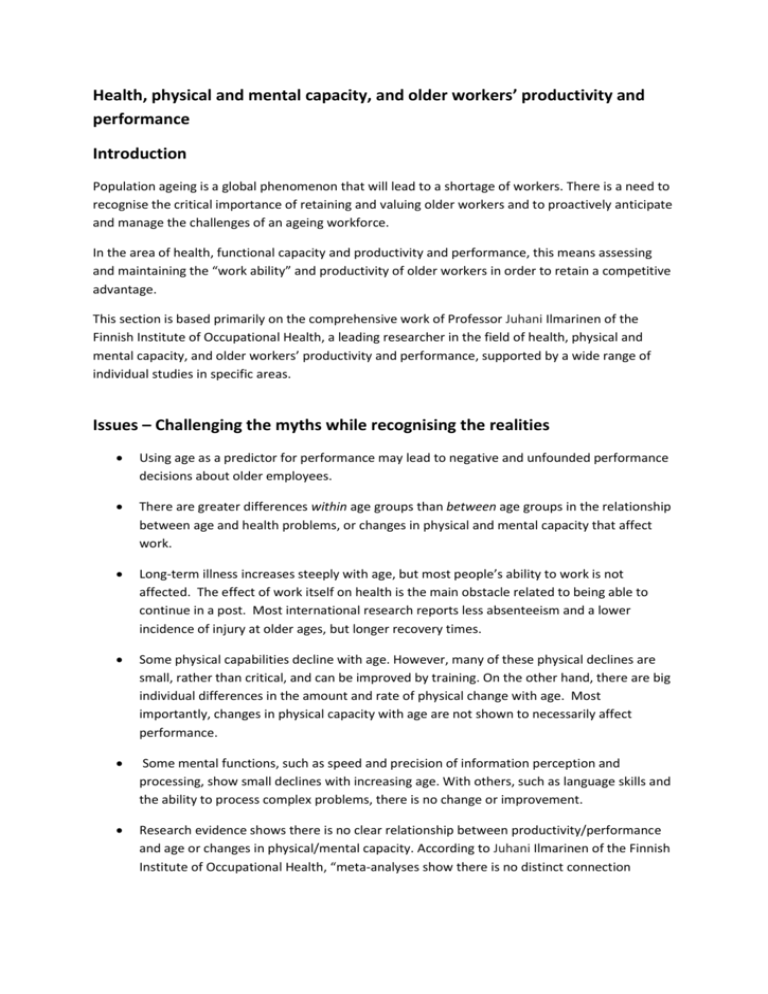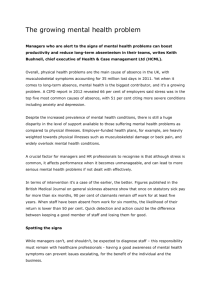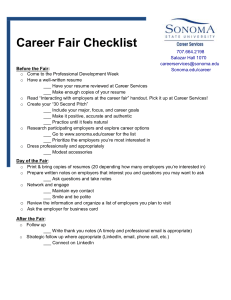Health, physical and mental capacity, and older workers` productivity
advertisement

Health, physical and mental capacity, and older workers’ productivity and performance Introduction Population ageing is a global phenomenon that will lead to a shortage of workers. There is a need to recognise the critical importance of retaining and valuing older workers and to proactively anticipate and manage the challenges of an ageing workforce. In the area of health, functional capacity and productivity and performance, this means assessing and maintaining the “work ability” and productivity of older workers in order to retain a competitive advantage. This section is based primarily on the comprehensive work of Professor Juhani Ilmarinen of the Finnish Institute of Occupational Health, a leading researcher in the field of health, physical and mental capacity, and older workers’ productivity and performance, supported by a wide range of individual studies in specific areas. Issues – Challenging the myths while recognising the realities Using age as a predictor for performance may lead to negative and unfounded performance decisions about older employees. There are greater differences within age groups than between age groups in the relationship between age and health problems, or changes in physical and mental capacity that affect work. Long-term illness increases steeply with age, but most people’s ability to work is not affected. The effect of work itself on health is the main obstacle related to being able to continue in a post. Most international research reports less absenteeism and a lower incidence of injury at older ages, but longer recovery times. Some physical capabilities decline with age. However, many of these physical declines are small, rather than critical, and can be improved by training. On the other hand, there are big individual differences in the amount and rate of physical change with age. Most importantly, changes in physical capacity with age are not shown to necessarily affect performance. Some mental functions, such as speed and precision of information perception and processing, show small declines with increasing age. With others, such as language skills and the ability to process complex problems, there is no change or improvement. Research evidence shows there is no clear relationship between productivity/performance and age or changes in physical/mental capacity. According to Juhani Ilmarinen of the Finnish Institute of Occupational Health, “meta-analyses show there is no distinct connection between age and work performance. Numerous studies show that older employees are as productive and skilled as young”. Performance at older ages is positively affected by investment in training, while negative stereotypes and ageist attitudes are linked to poorer performance. Physical and cognitive changes associated with ageing are modifiable or can be compensated for by experience and skill, training, exercise and ergonomic adaptations. In some cases, age linked with experience and skill increases performance. Another important research finding is that age differentials in cognitive abilities and productivity are less marked for more recent cohorts than they were in the past. Fewer jobs require physical capacity. Solutions – Managing the realities While most people aged 65+ are not in poor health and are still productive, there are widespread differences that need to be acknowledged and accommodated. As well as individual differences, some groups of older workers are affected more than others, such as workers in low-skill roles and Māori. The World Health Organisation recommends that older worker remain in employment, and says employers can facilitate this with support from occupational health services and by adjusting work environments to meet the needs of older workers. While older workers may have been regarded by employers in the past as dispensable, future demographics mean employers will need to adapt work to workers. According to Ilmarinen, “in order for people to continue to work, objectives must be set so they can be achieved with decreased functional capacity or deteriorated health”. A 2010 study by the UK’s Equality and Human Rights Commission found that “one-third of older workers in poor health feel unable to approach their managers to discuss difficulties and request more manageable working arrangements”. Employers could consider being more proactive in assessing and addressing the needs of older workers. This involves collecting data on the demographic profile of workforce, surveying attitudes to older workers and assessing the “work ability” of employees and what they need to continue contributing. Workplace changes Workplace changes will have the biggest effect on the ability of older workers to keep working, followed by ergonomic adaptations and then individuals’ lifestyles, according to Ilmarinen’s research. Research overall shows that the most important force for change is the workplace itself; baby boomers’ motivation for staying in work depends more on workplace factors than financial factors. Therefore, workplaces need to consider adapting to meet the needs of older workers. The degree of individual difference in functional capacity increases with age. Therefore, work ability, not age, should be the basis for decisions on continuing employment. While many future types of work require mental and social abilities that do not decline with age, physical and cognitive changes that are associated with ageing are modifiable. The way in which age-related issues are managed at work affects employees’ work ability and motivation to continue in employment. In order for people to continue to work, it is recommended that objectives be set that can be achieved with decreased functional capacity or deteriorated health, by, for example, making ergonomic changes or permitting flexible work arrangements such as reduced hours. Management and human resources Training for managers in managing an ageing workforce is recommended. This requires employers to be educated about the myths and realities of the health and physical and mental capacities of older workers so they can replace age-based stereotyping with research-based evidence on older people and performance. Management and HR should be aware of the increased variability in physical and cognitive abilities among older workers. While the majority of older workers have no work disabilities, others may need some kind of workplace adaptation to maintain performance. Employers should be made aware of age discrimination and stereotyping, and understand the need to respect older workers as well as value and recognise their existing knowledge and skills. Employers are in a position to actively prevent discrimination and negative attitudes to ageing by creating a positive culture towards older workers. A longitudinal Finnish study reported by Ilmarinen showed that changes in supervisors’ actions and attitude more than tripled work ability, while ergonomic changes doubled it. Employers can highlight positive examples and role models to counter negative stereotyping. Employers are encouraged to recognise, value and utilise the strengths of each age group: for example, combining the experience and wisdom of age with dynamism of young people. Retirement is a gradual process, not a set point. This may involve planning or workload, and ongoing learning to keep skills relevant. Ilmarinen recommends creating a positive workplace culture for all age groups and promoting good-practice age management by: o o o Emphasising that everyone gets older and not everyone ages in same way or at the same rate; Supporting the maintenance and improvement of work ability (through, for example, health promotion and support services); Adapting work structures and environment to individual needs and being flexible. Performance management and training Given the increasing disparity between individuals as they age, performance management of older workers is important in order to identify and address problems appropriately, such as offering training or making ergonomic adaptations where necessary. Yet research has shown older workers are less likely to get regular formal performance appraisal. Performance appraisal of older workers can be affected by the subjective biases of managers and supervisors, so there it is recommended managers’ attitudes and behaviour are assessed and addressed with appropriate training where necessary. Training and development for older workers is an important factor in reducing age disparities in performance. Health monitoring, assessment and promotion Employers are encouraged to view ageing as a process and take a proactive rather than a reactive approach. Health promotion in the workplace can prevent or slow decline in functional capacities; health and wellbeing programmes can maintain and improve the ability of older workers to continue working. Cost savings have been found through interventions to reduce work hazards and improve older workers’ fitness and health. Employers can ensure employees are trained to identify early warning signs, for example, of musculoskeletal disorders, as well as modifying jobs and work stations as a prevention strategy and educating employees in how to avoid and manage potential workplace issues such as back strain, tendonitis and carpal tunnel syndrome. Employers can also focus on what older workers can do as opposed to what they can’t do – that is, they should take a strengths-based approach. Physical work environments 1 Consider designing the workplace, the job and equipment so that any physical declines which may become more common at older ages don’t affect performance. Workplace ergonomic adaptations that may be useful include: Attention to lighting, noise control, heavy lifting, heights, computer screens, repetitive motions, control levers, workstation design, breaks, and recovery time1. In addition, employers are encouraged to provide training and practice on new equipment and in new processes. For details, see Haight, J. and Belwal, U. 2006: Designing for an aging workforce. Professional Safety, July:2033. Job design “Employees can remain in work life for a long time if the changes caused by ageing are taken into account and their tasks change according to their abilities” – Professor Juhani Ilmarinen, Finnish Institute of Occupational Health. Employers are encouraged to: Take into account individual changes in health and functional capacity when organising tasks and job descriptions for ageing employees. Design jobs to minimise the risk of injury. Alter the workload and tasks to fit changing capacities, such as reducing hours/days, and modifying or reassigning tasks, especially those that are physical. Recognise that longer recovery times are essential to maintaining health and wellbeing and continuing work at older ages; workloads should be adjusted to changing abilities and functional capacities. The ability to adjust to and recover from night shifts also declines with age, so there is a need to allow adequate recovery times in rostering shift work. View the impact on productivity of changing workload by weighing net benefits versus the potential loss of a worker. Recognise that job rotation can help to reduce musculoskeletal complaints and absenteeism; assistive devices are available for employees with arthritis. Offer flexible working arrangements and reduced hours. Offer older workers greater control over aspects of their job such as pace, breaks, method, schedules, and workload. Recognise that stimulating work, variety and control help maintain mental fitness. Individuals The most important thing older workers can do to maintain their functional independence and cognitive skills is regular exercise and fitness maintenance. Want more detail? The above is extracted from the fully-referenced EEO Trust report Older Workers: Challenging Myths and Managing Realities, available on request from the EEO Trust. Email admin@eeotrust.org.nz.






